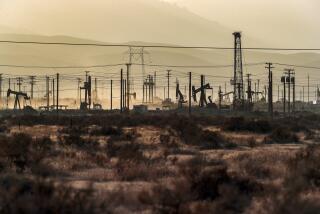Analysis: Trump has big plans for offshore oil development. But will it ever happen?
With characteristic flamboyance, the Trump administration has set in motion a grand scheme to lure energy companies to explore for oil and gas across virtually all of America’s outer continental shelf, a deep marine domain encompassing billions of acres of ocean bottom.
Drawing a distinction from the Obama administration’s concerns about climate change and restricting offshore fossil energy development, Interior Secretary Ryan Zinke cast President Trump’s offshore drilling campaign as a study in American strength. “We’re embarking on a new path for energy dominance in America,” Zinke said. “We are going to become the strongest energy superpower.”
Yet like other marquee directives that Trump has issued in the past year to empower the domestic fossil fuel industry, the offshore plan may not bear out its grand ambitions. Many energy analysts already are predicting that exorbitant costs, flat prices, civic opposition, climate concerns and new transportation technology make major new offshore drilling enterprises, at least outside the Gulf of Mexico, unlikely.
Even in the Gulf, which produces 1.6 million barrels of oil daily, or 16% of U.S. production, the cost of exploration, permitting and operations in deep water is well over $1 billion per well, according to the American Petroleum Institute.
Energy analysts also say it will take at least 10 years for a new well to begin producing in the Gulf, and twice that anywhere else on the outer continental shelf. By that time, according to industry forecasts, demand for oil will be well past its peak and dropping due to the advent of electric vehicles, more efficient engines for planes and ships and new materials that are not made with oil or natural gas.
In short, many of these experts say, the administration’s offshore drilling plan could be out of touch with its time. “The price of crude is the determining factor,” said Ron Stein, founder of PTS Staffing Solutions, an Irvine-based company that provides professional staff to energy companies. Producing oil offshore is a money-burner, he said. “If the price of oil isn’t right, they won’t do it.”
Others are of a similar view.
“There is no economic justification for going to the outer continental shelf, and there probably never will be,” said Lorne Stockman, a senior research analyst with Oil Change International, a clean energy research and advocacy group in Washington, D.C.
The administration’s agenda seems clear: With a series of executive orders issued early last year by the president, and regulatory changes ordered by Zinke, Trump has set out to reverse Obama-era restrictions on fossil fuel development. Offshore production has been a particular area of focus, not only because Obama had strictly limited access to the Atlantic and the Arctic, but also because government energy analysts have projected that tens of billions of barrels of untapped oil and trillions of cubic feet of natural gas lay beneath the oceans.
But getting at those reserves tests the limits of exploration and production technology, and it is expensive. In the early 1980s, a consortium of oil companies explored in Alaska’s Beaufort Sea, an area that the administration plans to open, but abandoned the effort when wells came up dry and costs soared over $2 billion. In 2015, Royal Dutch Shell, after spending $7 billion, abandoned its program of exploring for oil in the nearby Chukchi Sea after its drilling rig was battered by ice and storms and protests against drilling erupted on the West Coast.
The cost and difficulty of oil and gas exploration on the U.S. outer continental shelf is so high that some respected oil industry analysts have discouraged major companies from even trying. A recent study by Rystad Energy, a Norwegian consultancy that tracks the economics of development, found that trends in oil demand and weak pricing made developing new fields in the Atlantic and the Arctic impractical for decades.
“There just isn’t a lot that makes sense now or in the foreseeable future for offshore development,” said Peter Erickson, a senior scientist in Seattle with the Stockholm Environment Institute. “If prices stay around $50 a barrel, $60 a barrel, where they’ve been for some time, you’re not going to see any interest in drilling in these high-cost offshore areas.”
In California, where offshore rigs produce 16,000 barrels of oil daily, the same economic conditions exist. Analysts say the California coast will not see another offshore production platform until oil prices rise to at least $120 a barrel, a price unlikely to appear in an era of oil abundance and historically moderate prices.
Officially, the oil industry is still bullish. The American Petroleum Institute says developing new offshore tracts in the Atlantic, Pacific and Arctic, as well as the Gulf of Mexico, could generate $70 billion a year to the economy, 840,000 new jobs and the equivalent of 3.5 million barrels of oil a day.
“Some of the richest energy reserves in the world are just off our U.S. shores waiting to be discovered,” the API said.
Follow Keith Schneider, Western environment and public lands correspondent, on Twitter.
More to Read
Start your day right
Sign up for Essential California for news, features and recommendations from the L.A. Times and beyond in your inbox six days a week.
You may occasionally receive promotional content from the Los Angeles Times.






